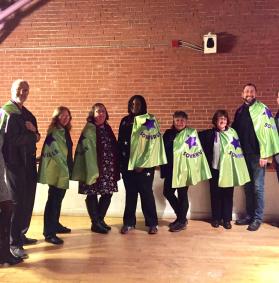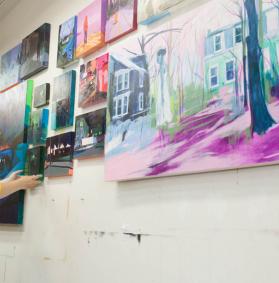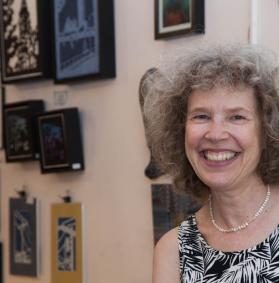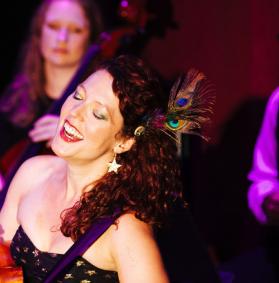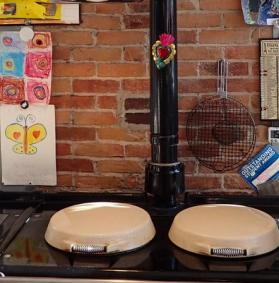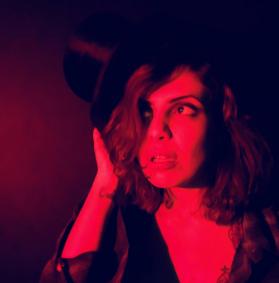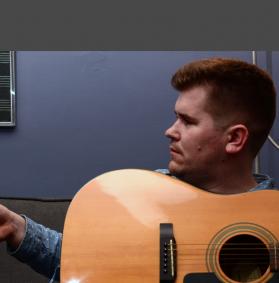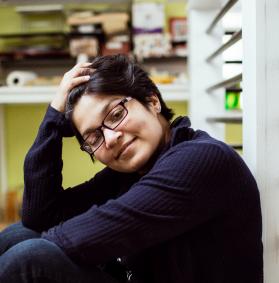An interview with Jane as told to, and photos by, Matt Kaliner.
For more information, please visit: http://www.janesherrill.com/ Or follow Jane at https://www.instagram.com/janesherrillart/
How would you describe what you do?
 I paint. All of my work is really about paying attention and noticing our environment, which is amazing. This world is gorgeous. I used to paint seascapes. I was interested in the particularities of different beaches—the color and the wave structure. I remember at the time, I felt like I was trying to paint each droplet of water because I noticed the drops moved in a different directions yet they all became a massive whole—all the molecules, energy, movement, and how it’s constantly changing—I needed to express that.
I paint. All of my work is really about paying attention and noticing our environment, which is amazing. This world is gorgeous. I used to paint seascapes. I was interested in the particularities of different beaches—the color and the wave structure. I remember at the time, I felt like I was trying to paint each droplet of water because I noticed the drops moved in a different directions yet they all became a massive whole—all the molecules, energy, movement, and how it’s constantly changing—I needed to express that.
What is your technique? What are you painting now?
I take photos of different places I visit and paint from them. Although I work from photos, my paintings are often nothing like the photos. You might not even connect the photo to the painting. I was working from a photo of a New Jersey beach, then Hurricane Sandy hit, and that beach was totally destroyed. That deeply affected me and I decided I needed to point out what we have, to show the beauty and amazing life that is right here and now. Since then I’ve turned to painting clouds, skies, and weeds and now I’m doing these trees.
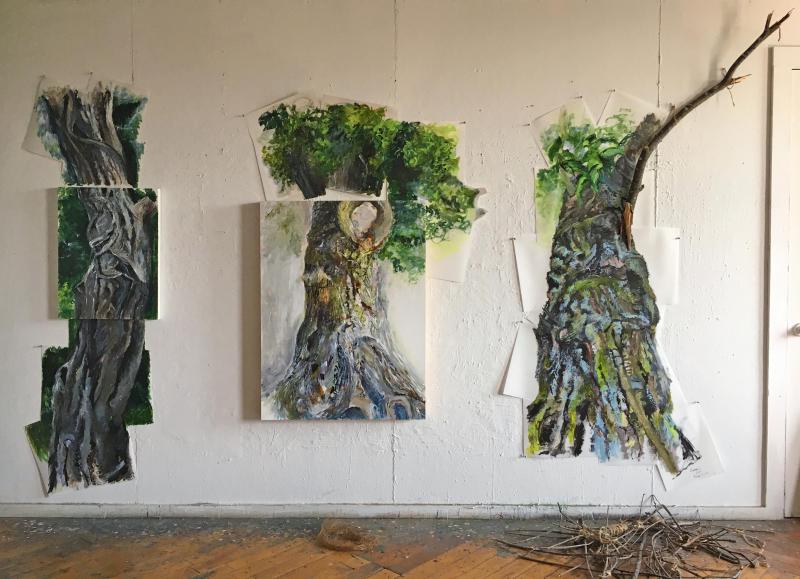 I love trees. I’ve always loved trees. At one point I remember—I think it was a very snowy year—I was looking at the trees and noticed they were wild with color—I was amazed by that. I would not have thought of the bark of trees as being green and red and violet and yellow, and all at once. So I began painting that. Lately I’ve been thinking of trees as a kind of a Noah’s Ark because they carry and sustain so many varieties of life including our own.
I love trees. I’ve always loved trees. At one point I remember—I think it was a very snowy year—I was looking at the trees and noticed they were wild with color—I was amazed by that. I would not have thought of the bark of trees as being green and red and violet and yellow, and all at once. So I began painting that. Lately I’ve been thinking of trees as a kind of a Noah’s Ark because they carry and sustain so many varieties of life including our own.
Most recently I’ve been branching out – doing some installation and sculpture, of trees. I’ve been reading books about recent research on trees and it is very exciting. I didn’t know how trees communicate with other trees, their use of mushroom and fungus, other vegetation and creatures to deal with drought and too much water. It amazes me!
Earlier this fall, when I walked into my studio, I heard a bothersome loud buzzing. I looked out the window and saw there were workers cutting down all the trees along the railroad tracks. They were clear cutting right through all the trees—every one. I was so upset, I wanted to run down and scream at them until I realized it had to do with GLX. I just stood there and cried. We all want GLX, but I hadn't considered the trees. I felt like they should at least be saying kaddish—some way of at least attending to this life, to these beings.
What was your training like? How did you come to painting?
I took one art class at Syracuse University and I got a D in it. I went to class but it was like I was in a different world from everyone else. The teacher would give out assignments and I always did what I thought he meant. I tried so hard but my interpretation of what was being asked of me was totally different from what was expected. I had thought I wanted to be an artist but after that class I dropped the idea. I ended up getting a masters degree in social work and I was a social worker for a while, in Gary, Indiana. I was writing at the same time, but I couldn’t do both so I moved to Manhattan and wrote poetry.
While in NYC I started doing these automatic drawings. I would sit in my apartment and look at a piece of blank paper and I would begin to draw shapes, all abstract. I moved to Wellfleet and began showing in galleries on the Cape. I fell in love with the ocean and the trees. I would walk for hours and get myself into meditative states where I could hear all the sounds around me individually and simultaneously and everything was visually in sharp focus all at once. I was drawing and I was writing and then the drawing started to take over.
My drawings continued to be abstract. I drew with pencil and graphite and erasers. Later I branched out into color by using pastels and I did that for awhile. I wanted to learn to paint, so I tried watercolor but what I did with it was just awful. I couldn't figure out how to use a brush – what is this stick that is wavy and soft on the end? It took awhile. I started to understand that color is light. I worked mainly with acrylics and some with oils. It was all abstract at first. I didn't plan my pictures, I would just begin. Then I began to plan a bit by choosing subject matter. I did a whole series of hand paintings, I did bones. When I chose a subject, I needed to focus in on it, I couldn't imagine how one could paint a whole landscape. It took me a while and a great deal of work for years to figure it out.
I started to paint seascapes while in Provincetown upon seeing a show of ocean paintings. The paintings were very nice but they were not the ocean I knew so I decided to paint my interpretation of the sea.
How does graphic design inform your art?
I used to be a graphic designer and I sort of like that give and take – it pushed me to explore a different kind of creativity—a creativity within boundaries. I find I enjoy commissions and I’ve had a number of them, all seascapes. When you design for a client you have to give them what they want. It's a challenge that can really push your creativity. How do you find the intersection between what you feel is a good painting and what the collector wants? For me, I enjoy that challenge.
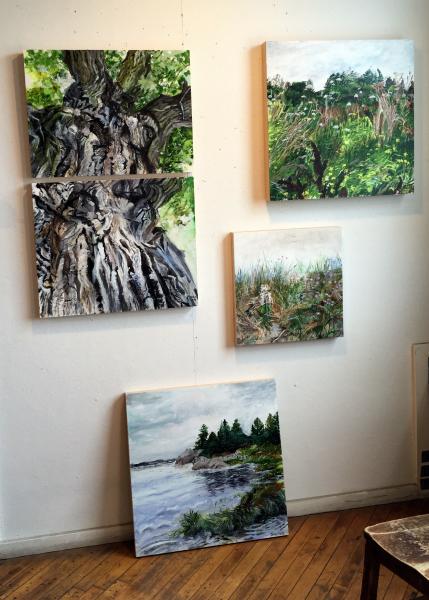 How did you choose Somerville?
How did you choose Somerville?
I had friends I met on the Cape who moved to Cambridge and at that time I felt the need to go back to a more citified environment. I moved to Cambridge with the plan to go back and forth between the Cape and Cambridge but I never moved back to the Cape. I found this studio at Vernon Street and that brought me to Somerville and this has been my studio ever since—my very first studio.
You’ve had a studio in Vernon Street for over 30 years. What was it like when you got here?
We all knew each other. We had parties! There was a guy who made pianos. We didn’t have door locks and at Easter he would come around with chocolate eggs and hide them in our studios. Well-known artists had studios in the buildings. Our open studios was so popular and packed with people you couldn’t even get through the hallways. It was really well known.
Thoughts on Somerville today?
I love Somerville – but I’m not happy with how it’s changing. I want all the funkiness of Somerville to remain. I want it to continue to have creative people living and working here, but money gets in the way. I love painting Somerville trees. Some of them are growing through fences. That’s tenacity, talk about persistence! They have to be celebrated. I sold a painting I called Bark and Butt, of a tree with a cigarette butt tossed in the snow beside it. Here are these gorgeous creatures that live among us and we pay them no attention yet they sustain us.
